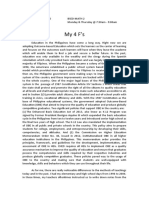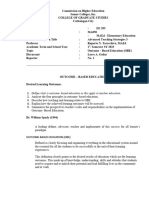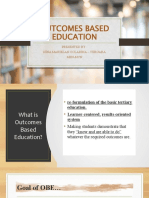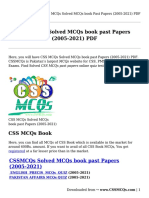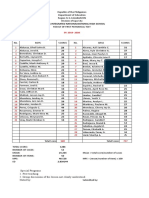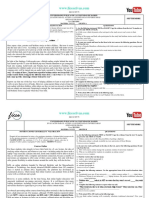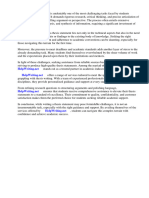“Good day, everyone.
I’m Grazel Ann Santos and together with my groupmates, we’re excited to
present our capstone project entitled ‘Outcomes-Based Education (OBE) for Teacher Preparation.’
This project explores how OBE shapes the design, implementation, and assessment of teacher
education programs in the Philippines.”
INTRO:
“Education is undergoing a major shift. Traditionally, we focused on what the teacher teaches—
textbooks, lectures, and tests. But in today’s world, that’s no longer enough. OBE focuses instead
on what the student learns and can do. The question now is not, ‘Did I teach this?’ but, ‘Did the
student learn this—and can they apply it?’ This is especially important in teacher education. We
need teachers who are not just knowledgeable, but also adaptive, reflective, and skillful.”
DEFINITIONS OF OBE:
“William Spady, the father of OBE, said it best: ‘Start with a clear picture of what is important for
students to be able to do, then organize the curriculum, instruction, and assessment to make
sure that learning happens.’ So in OBE, we design our lessons backwards. We ask:
According to William Spady (1994), Outcomes-Based Education (OBE) starts with a clear
picture of what students should be able to do after learning because the whole point of
education is to achieve specific results, not just to cover content.
• What do we want our students to achieve?
• How will we help them get there?
• And how will we know they got there?”
Principle 1: Example:
If a teacher wants students to learn critical thinking through analyzing a novel, the outcome
could be:
"Students should be able to analyze the themes of the novel and present their
interpretations in an essay."
This way, both the teacher and students know what the target is — not just reading the novel,
but analyzing it critically.
Principle 2: Example:
In a science class, the outcome could be:
"Students should be able to conduct an experiment and explain their findings using
scientific methods."
To achieve this, the teacher might plan backwards, deciding first to teach concepts like
hypothesis testing, data collection, and analysis, then assess how well students can apply
those concepts.
Principle 3: Example:
In an English class, a teacher might set the expectation that every student will write an
argumentative essay that includes evidence and addresses counterarguments.
Even if it seems difficult, the teacher’s belief in the students' ability to meet this standard
encourages them to put in their best effort.
Principle 4: Example:
In a math class, a teacher could provide extra tutoring sessions, alternative learning
�materials, or online resources to ensure that students who struggle with certain topics can
still succeed, while advanced students have additional challenges to push their learning further.
RATIONALE:
OBE is important because it ensures that future teachers—like us—develop the right skills,
knowledge, and attitudes needed for 21st-century teaching.
OBE focuses on clear and specific outcomes. That means everything we learn in our program—
lessons, activities, and assessments—is designed to help us reach those goals. It prepares us to
be effective teachers who are not only knowledgeable, but also capable of applying what we’ve
learned in real classroom situations.
This approach also promotes student-centered learning. It encourages us to be active
participants, to practice real teaching strategies, and to reflect on our performance so we can
keep improving.
Lastly, OBE helps teacher education programs meet global standards. It ensures quality,
accountability, and relevance in what we learn—so that when we graduate, we are not just ready
to teach, but ready to make a real impact.
NATIONAL TRENDS:
Curriculum change in the Philippines is influenced by the country’s social, economic, and cultural
needs. One major trend is making education more inclusive. This includes integrating
indigenous knowledge systems, using mother tongue-based multilingual education,
and promoting gender sensitivity in our lessons.
Another important goal is to make sure students learn practical and employable skills that
match what industries and employers are looking for. This helps prepare students for real-life
jobs.
There is also a strong push for educational equality, making sure that all students—including
those from marginalized groups—have access to quality learning.
A good example of these reforms is the K-12 Basic Education Program in the Philippines. It
expanded basic education to 12 years and added more focus on vocational and technical
training, helping students become more job-ready after graduation.
DISADVANTAGES:
First, many teachers don’t want to change to OBE.
According to Ahmad, Sulaiman, and others (2021), some older teachers are used to the old
style of teaching and didn’t get training for OBE. That’s why they find it hard to follow the
new system.
Example: It’s like asking someone to cook a new recipe without giving them the
instructions—they’ll feel confused.
Next, it’s hard to create clear learning goals and measure them.
World News Fox (n.d.) says some goals are too broad or don’t match what students need
for real jobs.
Example: If a goal says, “students must think critically,” how do we test that? Different
teachers may score it in different ways.
� According to Suryanto and Prayitno (2021), OBE makes teachers more stressed because
they have to match every lesson and test with the outcomes.
Example: Before, a teacher could use one quiz. Now, they have to make different tasks
for each goal. It takes a lot more time and energy.
Ahmad et al. (2021) also said that many schools do not have enough support—like
training, internet, or materials—to make OBE work.
Example: If a school wants teachers to use computers, but has no computers or Wi-Fi,
how can OBE really happen?
Harappa Education (n.d.) explains that OBE focuses too much on things that can be
measured, like test scores.
Example: If a student is good at art or teamwork, but these are not included in the
outcomes, they may not be recognized for their talents.
Lastly, K12 Academics (n.d.) says there is not enough research to prove that OBE
really improves learning.
Even though many schools use it, we still don’t know for sure if it is better than
traditional teaching.





























